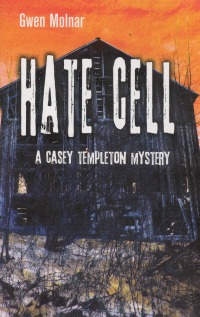| ________________
CM . . .
. Volume XVI Number 36. . . .May 21, 2010
In Hate Cell, Gwen Molnar has created a strong and intelligent hero in Casey Templeton. Casey at the age of 14 has lived in six different places and has just moved to his parents’ home town. Small-town Alberta should be safe and secure, but Casey, short for Knightly Charles, faces many challenges, including being the new kid:
Casey had learned a lot about the new kid role, knew you never let them know you were lonely. You just did your own thing and played it very, very cool. A way to become an insider would always come up if you didn’t push, if you stood back, listened, and bided your time. Take today for instance. He had heard Kevin Schreiver and Terry Bracco talking when he was in a little storage closet putting away the basketballs after gym. Casey had been at the school long enough to know that Kevin and Terry were the kind of guys he would like for friends. Part of Casey’s appeal to me was his positive attitude and his practical and logical approaches to problems. He may be the new kid, but he is an experienced new kid, with a plan for finding his place in a new town and school. He also cares for other fringe members of his community and tries to help them as well as securing his place with the in-crowd. He also feels that he doesn’t know his father, who has travelled to Afghanistan and other locations as an RCMP officer. Casey feels that he needs to impress his father (now retired), and to do that, he decides to solve a mystery. The seemingly quiet, idyllic town of Richford has a problem. Hate crimes are being perpetrated against Jews and Gypsies. Casey finds himself in the thick of it after he discovers the hypothermic and injured body of one of his teachers outside the old Willson (with two l’s) place, the abandoned home of Richford’s richest family. Casey manages to maneuver Mr. Deverell’s body into the house, make a fire to warm him, and discovers that the attic has been used by the “hate cell” for a base when he finds their computers in the attic. He e-mails for help - no phone - and then starts to walk in the dark through the heavily falling snow back to town, when help has not arrived after several hours. Both he and Mr. Deverell end up in the hospital. Casey recovers overnight; Mr. Deverell is still unconscious. Casey’s father is called upon by the local RCMP to assist because, even though he is retired, he has experience in the area of hate crime. Casey’s older brother Hank, who is proclaimed (on little evidence) to be a computer expert, is also enlisted to help. Casey feels that he has some information that the RCMP doesn’t have and decides to pursue these clues on his own. Casey’s two clues are brass screws that are difficult to obtain, as he knows from having to special order them at the local hardware store for a science project, and the custom draperies that were hanging at the window, which the RCMP haven’t seen because Casey burned them to warm the room. Casey is very clever and lucky in following these clues. The mystery proceeds in a logical manner with adequate suspense as Casey, Hank, and friends close in on the sometimes violent perpetrators. While I appreciated the simple, fluid writing style and the logical procession of details, there were a number of points that seemed unlikely. And though we are encouraged in Alice in Wonderland to believe ten impossible things before breakfast, too many unlikely things can break the back of a realistic mystery. It was unlikely that a racist terrorist group would purchase custom draperies for their hide-out. It was unlikely that a 14-year-old boy would recognize the fabric and realize that the draperies were custom. (Casey does seem unusually interested in fabric and fashion, as he describes Maria McKay, the Roma or Gypsy woman who had been run down by a van ”She wore a silver-blue tailored blouse and an ankle-length skirt of flowing cornflower-blue silk.”) It was unlikely that a terrorist group would, after buying a computer for cash, sign a three-year service agreement and thereby forfeit the anonymity of a cash sale. It is unlikely that Hank would be riding his Harley-Davidson motorcycle in the winter in Alberta. And, I am assured by my public librarian friends, it would be unlikely, because it would be unethical, for a public librarian to help Casey find the personal information about the suspects as the librarian in this story does. The book would have benefitted by more careful editing. There are extra words in the text on p. 84 and clichéd language on p. 41 (“Casey with wisdom beyond his fourteen years.”). The cover depicts what looks like a derelict barn, not the abandoned house of the richest family in town. In conclusion, though I was drawn to the resourcefulness of the character, Casey Templeton, and wished that all new kids could be as successful as he is in finding their place in a new community, the mystery as a whole seemed contrived. While it might be acceptable to upper elementary readers, it would not be acceptable to more sophisticated junior high readers. Not Recommended. Rebecca King is a Library Support Specialist with the Halifax Regional School Board in Halifax, NS.
To comment
on this title or this review, send mail to cm@umanitoba.ca.
Copyright © the Manitoba Library Association. Reproduction for personal
use is permitted only if this copyright notice is maintained. Any
other reproduction is prohibited without permission.
NEXT REVIEW |
TABLE OF CONTENTS FOR THIS ISSUE
- May 21, 2010.
AUTHORS |
TITLES |
MEDIA REVIEWS |
PROFILES |
BACK ISSUES |
SEARCH |
CMARCHIVE |
HOME |
